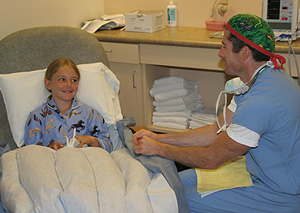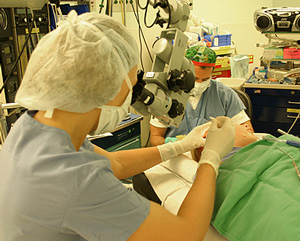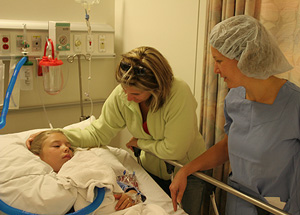
Photo Journal: Myringotomies with Tube Insertions
Katrina* is a 7 year old girl with a history of chronic middle ear infections requiring treatment with frequent courses of antibiotics. Her pediatrician recommended evaluation by an ENT specialist to determine if the placement of ear tubes would help Katrina's situation. Dr. Bock reviewed the patient's history and determined that Katrina was a good candidate for tube insertions (myringotomys with tubes); therefore, she was scheduled for surgery and had a preoperative consultation with Dr. Bock, her pediatrician and the Mills Hospital Surgery Center in preparation for this procedure.
On the day of surgery, Katrina and her mother (not shown in photo), meet with the anesthesiologist, Dr. Wilk, who reviews his anesthetic plan and answers any questions prior to surgery.
 After Katrina is asleep using a light, general anesthetic, Dr. Bock examines Katrina's ear under a microscope. Wax is removed from the ear canal, then once the ear drum is clearly visualized, Dr. Bock makes a small, painless incision in the ear drum (myringotomy). Accumulated fluid or pus in the middle ear space is removed with a tiny suction device. Next, a tube is inserted into Katrina's ear drum. The tube is very small and can only be seen by an examiner using a special light, called an otoscope. The tube will remain in place for 12 to 18 months and should reduce Katrina's frequent ear infections. Katrina will see Dr. Bock one week after surgery and then every 3-4 months until the tubes extrude.
After Katrina is asleep using a light, general anesthetic, Dr. Bock examines Katrina's ear under a microscope. Wax is removed from the ear canal, then once the ear drum is clearly visualized, Dr. Bock makes a small, painless incision in the ear drum (myringotomy). Accumulated fluid or pus in the middle ear space is removed with a tiny suction device. Next, a tube is inserted into Katrina's ear drum. The tube is very small and can only be seen by an examiner using a special light, called an otoscope. The tube will remain in place for 12 to 18 months and should reduce Katrina's frequent ear infections. Katrina will see Dr. Bock one week after surgery and then every 3-4 months until the tubes extrude.
 Shortly after surgery, Katrina recovers from her procedure in the post-anesthesia care unit (PACU).
Her mother and Dr. Bock are present to check on her progress and to make certain she is comfortable.
Shortly after surgery, Katrina recovers from her procedure in the post-anesthesia care unit (PACU).
Her mother and Dr. Bock are present to check on her progress and to make certain she is comfortable.
*Our patient's name is changed to protect her privacy. We would like to thank her and her parents for helping us put together this journal which will help other families prepare for surgery.

